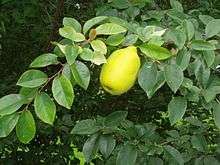Pseudocydonia
| Pseudocydonia | |
|---|---|
 | |
| Pseudocydonia sinensis | |
| Scientific classification | |
| Kingdom: | Plantae |
| (unranked): | Angiosperms |
| (unranked): | Eudicots |
| (unranked): | Rosids |
| Order: | Rosales |
| Family: | Rosaceae |
| Subfamily: | Amygdaloideae[1] |
| Tribe: | Maleae |
| Subtribe: | Malinae |
| Genus: | Pseudocydonia |
| Species: | P. sinensis |
| Binomial name | |
| Pseudocydonia sinensis | |
| Synonyms[2] | |
Pseudocydonia sinensis, the Chinese quince, is a deciduous or semi-evergreen tree in the family Rosaceae, native to eastern Asia in China, and the sole species in the genus Pseudocydonia. It is closely related to the east Asian genus Chaenomeles, and is sometimes placed in Chaenomeles as C. sinensis,[3] but notable differences are the lack of thorns, and that the flowers are produced singly, not in clusters. The Chinese quince is also closely related to the European Quince genus Cydonia;[4] notable differences include the serrated leaves, and lack of fuzz.
In China, the species is called mùguā-hǎitáng (木瓜海棠), while in Korea, it is called mogwa-namu (모과나무). The name of its fruit, mùguā (木瓜) in Chinese and mogwa (모과) in Korean, are cognates, the latter having derived from mokgwa (목과; 木瓜), the Korean reading of the same Chinese characters. In Chinese, mùguā (木瓜) also means "papaya". In Japan, it is called karin (花梨; rarely, also 榠樝), and the fruit, when referred to for its medicinal properties, is also called wa-mokka (和木瓜), a cognate derived from the Chinese and Korean names[5].
It grows to 10–18 m tall, with a dense, twiggy crown. The leaves are alternately arranged, simple, 6–12 cm long and 3–6 cm broad, and have a serrated margin. The flowers are 2.5–4 cm diameter, with five pale pink petals; flowering is in mid spring. The fruit is a large ovoid pome 12–17 cm long with five carpels; it gives off an intense, sweet smell and it ripens in late autumn.
Uses
The fruit is hard and astringent, though it does soften and becomes less astringent after a period of frost. It can be used in the same way as quince is used for making jam. It is also grown as an ornamental tree in southern Europe.
In Korea, the fruit is used to make mogwa-cheong (preserved quince) and mogwa-cha (quince tea).
The wood of this plant is frequently used in Japan for making low-end shamisen.
The fruit is used extensively in Traditional Chinese Medicine to treat rheumatoid arthritis (termed as "damp bi syndrome").[6] Recent pharmacological studies suggest extracts of phytochemicals in the fruit have antioxidant and antiviral properties.[7]
Gallery
 A trunk of Pseudocydonia
A trunk of Pseudocydonia A leaf of Pseudocydonia
A leaf of Pseudocydonia
See also
- the flowering quinces, genus Chaenomeles
- the "true" Quince (Cydonia oblonga)
References
- ↑ Potter, D.; Eriksson, T.; Evans, R. C.; Oh, S.; Smedmark, J. E. E.; Morgan, D. R.; Kerr, M.; Robertson, K. R.; et al. (2007). "Phylogeny and classification of Rosaceae". Plant Systematics and Evolution. 266 (1–2): 5–43. doi:10.1007/s00606-007-0539-9. [Referring to the subfamily by the name "Spiraeoideae"]
- ↑ "Pseudocydonia sinensis". Germplasm Resources Information Network (GRIN). Agricultural Research Service (ARS), United States Department of Agriculture (USDA). Retrieved 29 December 2017.
- ↑ Gu Cuizhi and Stephen A. Spongberg, 2003. Flora of China (entry under Chaenomeles sinensis)
- ↑ Campbell, C.S.; Evans, R.C.; Morgan, D.R.; Dickinson, T.A.; Arsenault, M.P. (2007). "Phylogeny of subtribe Pyrinae (formerly the Maloideae, Rosaceae): Limited resolution of a complex evolutionary history" (PDF). Plant Systematics and Evolution. 266 (1–2): 119–145. doi:10.1007/s00606-007-0545-y.
- ↑ ja:カリン (バラ科)
- ↑ Lim, T. K. "Pseudocydonia sinensis." Edible Medicinal And Non-Medicinal Plants. Springer Netherlands, 2012. 515-522.
- ↑ Hamauzu, Yasunori, et al. "Reddish coloration of Chinese quince (Pseudocydonia sinensis) procyanidins during heat treatment and effect on antioxidant and antiinfluenza viral activities." Journal of agricultural and food chemistry 55.4 (2007): 1221-1226.
| Wikimedia Commons has media related to Pseudocydonia. |